One Day In Sequoia National Park: The Perfect Itinerary (Epic!)
By Jessie Festa. This guide on what to do in Sequoia National Park with one day contains affiliate links to trusted partners!
Looking for the perfect itinerary for spending one day in Sequoia National Park?
Then you’re in the right place!
Located in the southern Sierra Nevada mountains, Sequoia National Park features 631 square miles — or 1,351 square miles if you include the adjacent Kings Canyon National Park — of expansive meadows, alpine lakes, high peaks, stunning waterfalls, and giant sequoia trees.
Recently, I was fortunate enough to visit this California national park and had an incredible time. Not only did I see gorgeous scenery and do some of the best hikes I’ve ever done, but I learned a lot about how to best explore the park — which I’ll share in the guide below!
Specifically, you’ll find suggestions for how to spend a day in Sequoia National Park while still seeing a lot and having an incredible time.
The beginning of this guide will cover logistical information. From there, we’ll dive into two options for your Sequoia National Park one day itinerary. Finally, we’ll end by going over some important tips as well as frequently asked questions about the park.
🥾 Pro tip: Before going hiking, make sure to download the AllTrails app to have trail guides, maps, photos, and reviews right at your fingertips. You can also sign up for a free trial of AllTrails+ to download offline maps, get alerts for wrong turns, find trails by distance from you, and more!
💪 Safety: Additionally, whether you’re hiking solo or in a group, it’s smart to keep safety in mind. One piece of advice is to carry a She’s Birdie Personal Safety Alarm, which features a 130db alarm and flashing strobe light designed to deter an attack. I also love the Garmin inReach Mini, a compact satellite communicator with SOS capabilities that can truly save your life in an emergency.
What Type Of Hiker Are You? [Free Quiz]
But first, before we dive into how to spend 1 day in Sequoia National Park, I want to share a free personality quiz I think you’ll love:
Discover your hiking persona in this fun and short hiker personality quiz, which also shares trail suggestions based on your results.
Once you’ve grabbed the quiz, let’s create your perfect plan for a one day trip to Sequoia National Park, with two itinerary options to choose from. You can also add in some of the top Sequoia attractions listed below to customize your schedule.
Get excited, as visiting the park is one of the top California travel experiences — especially as it’s home to some of the best hiking trails in the world!
Getting To Sequoia National Park
Sequoia National Park is located in California, with the nearest airports being Fresno Yosemite International Airport (about 1 hour and 15 minutes away) and Visalia Municipal Airport (about 1 hour away). That being said, there are many other airports that are just a few hours away by car.
Having your own vehicle is recommended, as it gives you flexibility when it comes to creating your itinerary for Sequoia and allows you to explore on your own time.
If you’d prefer to take public transportation, your options include:
Bus: You can take a Greyhound bus to Visalia and then switch to a park shuttle bus or the local V-Line bus. Just note that both of these options operate in summer only.
Otherwise, you can take a Greyhound bus to Visalia or Fresno and rent a car from there.
From Visalia, you can also take Tulare County Area Transit to the town of Three Rivers to connect with a guided tour. Just make sure to pre-book your excursion so you know when and where to meet your guide.
Train: Amtrak goes to Fresno, where you can rent a car.
Additionally, it goes to Hanford where you can connect to an Amtrak bus to Visalia. From here, you can rent a car or, in summer, connect with a park shuttle.

Getting Around Sequoia National Park
Renting A Car For Sequoia National Park
Sequoia National Park is huge, and you’ll definitely want a car to explore the many trails and sites.
If you need to rent a car, I highly recommend using Discover Cars to quickly compare your rental options.
Their comparison tool does the homework for you, so there’s no need to have 10+ tabs up trying to figure out which company is the most affordable. Actually, you can save up to 70% using their tool!
Sequoia National Park Shuttle & Buses
Your other option for getting around Sequoia National Park is the free park shuttle service. Many people actually drive to the park and then use the free shuttle to get around.
You can find full information on routes and schedules here.

Best Time To Visit Sequoia National Park
While Sequoia National Park is open year-round, not every season offers the same experience. Here are some considerations when choosing when to visit Sequoia National Park.
Summer. In my opinion, this is the best time to visit. Not only is the weather more reliable than other times of year, but there are also more shuttles and programming — not to mention all of the park areas are typically open (unless, for example, a wildfire closes it down).
Fall. While beautiful, the weather can be unpredictable. This is also when you’ll see less programming and shuttle service as well as the closure of the park’s Mineral King and Cedar Grove areas for the season.
Love festivals? Between August and September is the annual Dark Sky Festival, which involves speakers, stargazing and astrology events, nighttime photography sessions, and more!
Winter. On the positive side, there are winter showshoe walks — plus seeing the sequoia trees blanketed in snow is stunning; however, some areas of the park may be closed for the season or due to snow. Additionally, you may need tire chains. Note: There are no winter shuttles in Kings Canyon National Park.
Spring. Visiting in late spring is another good option, especially as the summer shuttles run from late May through mid-September. Moreover, seeing the park come alive with wildflowers and birds adds an enchanting energy to the park.
Pro tip:
No matter what season you decide to visit Sequoia National Park, check their Current Conditions page for closures and updates so you’re totally prepared.
Map Of Sequoia National Park
Before visiting, it’s recommended to print out a map of Sequoia National Park. This is one of my top solo hiking tips, though it’s also important if you’re in a group.
You can click here to do that.
Note: You’ll get a paper Sequoia map when entering the park and there are maps posted everywhere (shown below) for you to easily take a photo of with your phone.
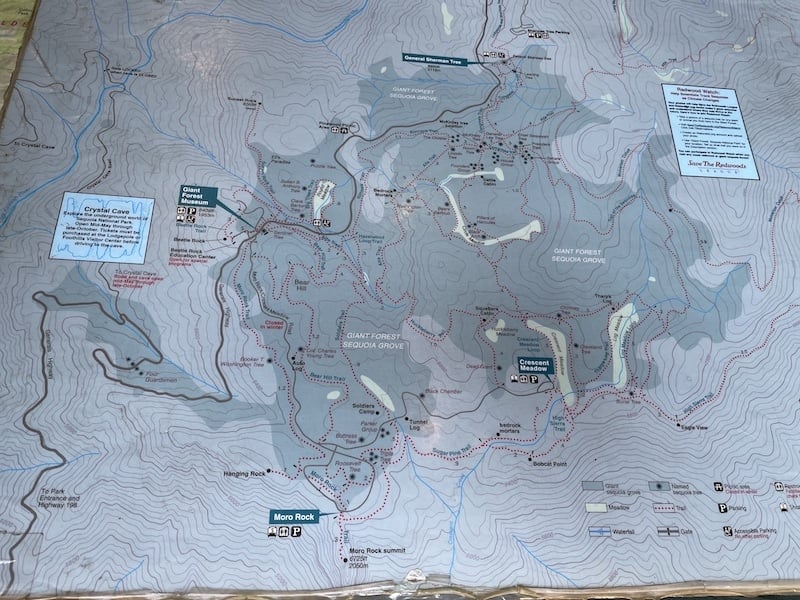
Sequoia National Park Logistics (Entrance Fees, Permits & Closures)
Sequoia National Park fee: $35/vehicle (valid for seven days)
Discount Passes: You can purchase a Sequoia & Kings Canyon Annual Pass for $70 or an America the Beautiful—National Parks and Federal Recreational Lands Annual Pass for $80. The latter is great if you plan to visit multiple national parks within a year.
Park Sections: Sequoia and Kings Canyon are adjoining national parks that showcase five specific sections you can explore, including:
- Foothills (Sequoia)
- Mineral King (Sequoia)
- Giant Forest & Lodgepole (Sequoia)
- Grant Grove (Kings Canyon)
- Cedar Grove (Kings Canyon)
Entrances: To maximize time with your Sequoia National Park one day itinerary, it’s wise to map out your route beforehand and know which entrance is best to come in through. Options include:
- Ash Mountain Entrance into Sequoia National Park via Highway 198 in Three Rivers
- Big Stump Entrance into Kings Canyon National Park via Highway 180 in Fresno
- Lookout Point Entrance to the remote Mineral King Area in Sequoia National Park via the junction of Mineral King Road with Highway 198 in Three Rivers
Wilderness Permits:
- During Quota Season (about late May to mid-September) there are a limited number of wilderness permits available each day for a fee
- During Non-Quota Season (about mid-September to late May) permits are free, self-issued, and are not limited daily
You can find full information about wilderness permits here.
Food/Drink: There are a number of places to buy food within Sequoia National Park, from quick grab-and-go spots to nicer restaurants like the Peaks Restaurant at Wuksachi Lodge.
Gas: There are no gas stations within Sequoia National Park.
Sequoia Closures: Check the Sequoia National Park website for updates on any trail or facility closures. You can view current conditions here.
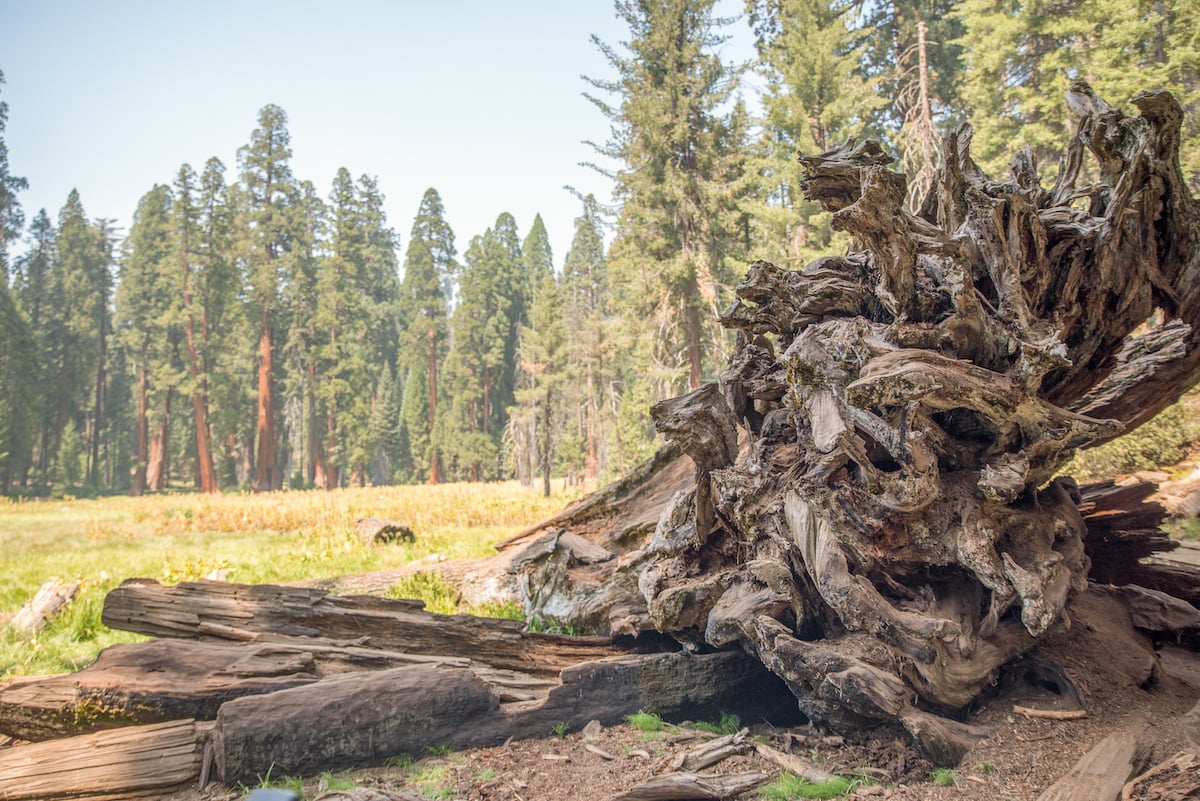
Where To Stay In Sequoia National Park
Because Sequoia National Park is so large, the closer you can stay to the park, the better.
If you want to stay directly inside of the park, some top options include:
Wuksachi Lodge. Located in Sequoia’s Giant Forest area, the lodge offers contemporary accommodations as well as an onsite restaurant, lounge, and gift shop.
John Muir Lodge. Located in Kings Canyon’s Grant Grove Village, this comfortable lodge also has an onsite restaurant.
Grant Grove Cabins. If you’d prefer cabin-style accommodation, these are also located in Kings Canyon’s Grant Grove area.
Cedar Grove Lodge. Open from spring through fall, this accommodation is located in Kings Canyon’s Cedar Grove area and features comfortable rooms as well as an onsite snack bar, market, and gift shop.
Note that there is also wilderness lodging onsite, as well as hotels outside of Sequoia National Park that are very nearby, like these Three Rivers accommodations which are as little as one minute from the park’s Ash Mountain Entrance.
Want to peruse other options for local accommodation?
Click here for a full list of hotels near Sequoia National Park!
Prefer self-contained stays?
Click here to view unique local rentals!
You can also peruse the map below. It’s set to Three Rivers, the closest town to Sequoia’s Ash Mountain Entrance, but you can easily change the destination based on where you’d like to stay.
Top Sequoia National Park Attractions
Here are some of the top attractions in Sequoia National Park that you may want to add to your one day itinerary, separated by park section.
This list also includes the best trails in Sequoia National Park in case you want to go hiking — which you should!
Foothills
Tunnel Rock. One of Sequoia National Park’s wheelchair-accessible attractions, Tunnel Rock is a giant piece of granite that forms an arch or gateway by resting on a neighboring rock. It’s a great spot for interesting photos.
Marble Falls Trail. This moderate-hard 7.4-mile out-and-back trail takes you to a beautiful waterfall.
Hospital Rock Picnic Area. Here you can see rock paintings and view exhibits on the Native Americans who once inhabited these lands. Additionally, you can take a short hike to a waterfall.
Paradise Creek Trail. This easy 5.5-mile out-and-back trail is pretty in spring when you can see wildflowers and waterfalls.
Mineral King
Cold Springs Nature Trail. From Cold Springs Campground, hike about 1 mile through lovely meadows and aspen groves.
Eagle Lake. This difficult 6.5-mile out-and-back trail showcases a lovely alpine lake and High Sierra scenery.
Paradise Ridge. This beautiful hike takes you through the park’s famous sequoias to a ridge showcasing stunning vistas of the Great Western Divide.
Atwell-Hocket to Deer Creek Hike. On this trail, pass sequoias, an old saw mill, and a waterfall. After 1.5 miles, you’ll reach Deer Creek, which is a good time to turn back. Otherwise, you can keep hiking into the wilderness.
Monarch Lakes. One of the park’s more beautiful hikes, this difficult 8.4-mile out-and-back trail features stunning mountain scenery and the Lower and Upper Monarch Lakes.
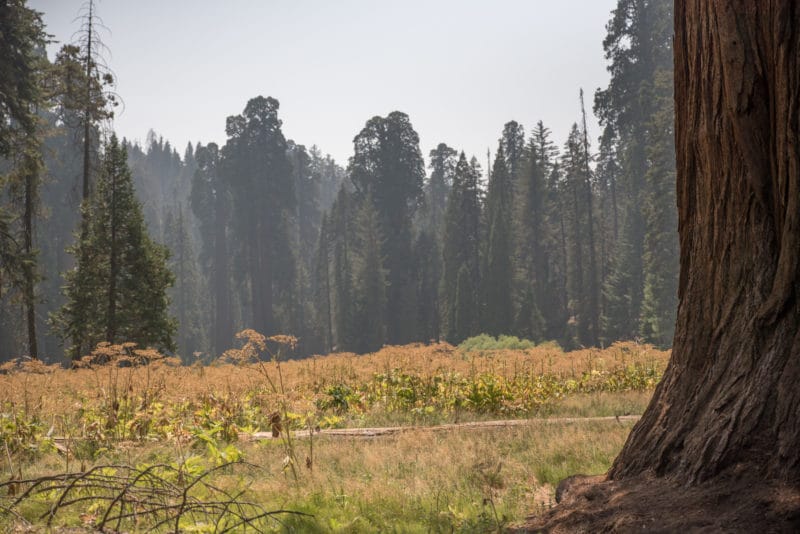
Giant Forest and Lodgepole
Crystal Cave. This is one of the best parts of Sequoia National Park! Open in summer only, visitors can go into a stunning marble karst cave. It’s recommended to purchase (mandatory) tickets to the cave at least 36 hours in advance.
General Sherman Tree. General Sherman is the largest tree in the world by volume. You have two options for hiking trails to reach this iconic Sequoia National Park highlight, one of which is wheelchair-accessible.
Moro Rock Trail. This moderate 0.5-mile out-and-back trail involves climbing a steep staircase up to a granite dome offering one of Sequoia National Park’s best views. Note that this hike is off Cresecent Meadow Road, which may be closed to vehicles on weekends and holidays.
Tunnel Log. In 1937, a 21-foot-wide sequoia tree fell across the road. As it was too heavy to move, a hole was cut through it to create an arch you can drive through — hence the name Tunnel Log.
Alta Peak Trail. Love adventure travel? This strenuous 14.9-mile out-and-back trail offers some of the best views in the park. In fact, you may get the urge to climb Mount Whitney, as you can see this high peak — the highest mountain in the contiguous United States — from the top.
Big Trees Trail. This gorgeous 1-mile loop takes you around a meadow (called Round Meadow) framed by giant sequoias. It is paved and wheelchair-accessible.
Tokopah Falls. This moderate 4-mile out-and-back trail takes you to a beautiful (seasonal) waterfall. Even when the waterfall is dried up, it’s a lovely trail.
Beetle Rock. This easy, paved 0.5-mile trail takes you to Beetle Rock for beautiful views of the western edge of Sequoia NP and the San Joaquin Valley below. The Beetle Rock trail is technically wheelchair-accessible though it may be tough for some as it slopes in certain areas.
Little Baldy. This moderate 3.3-mile out-and-back trail is known for its beautiful wildflowers and stunning 360-degree views from the top — without the crowds.
The Lakes Trail. This difficult 12.2-mile trail introduces you to three gorgeous mountain lakes.
Panther Gap. This 6-mile hike offers stunning views from the top! You’ll take the above-mentioned Lakes Trail before switching paths and hiking up 1,000 feet to Panther Gap.
Sunset Rock. This easy 2-mile out-and-back trail takes you to a granite dome offering panoramic views that are perfect for sunset.
Cahoon Meadow. This moderate 5-mile out-and-back trail takes you along the Twin Lakes Trail to a lovely tucked away meadow.
Bear Hill Trail. This easy 1.9-mile loop trail is known for its wildlife spotting opportunities — particularly deer and bear. Keep an eye out for bear claw marks on the trees.
Remember, too, that there are also trails and sites in Kings Canyon National Park at Grant Grove and Cedar Grove. While I won’t go over all of those here, I will point out one particularly beautiful trail in Cedar Grove, Mist Falls.
Not to be confused with the Mist Trail in Yosemite National Park, Sequoia’s Mist Falls is a 9-mile out-and-back trail with an elevation gain of 800 feet that takes you to one of the largest waterfalls in the park.
Moreover, the Kings Canyon Scenic Byway is a stunning drive — especially if you’re creating a California road trip itinerary.
If you’re wondering what to do in Sequoia National Park, the above list of ideas should certainly keep you occupied for a while!
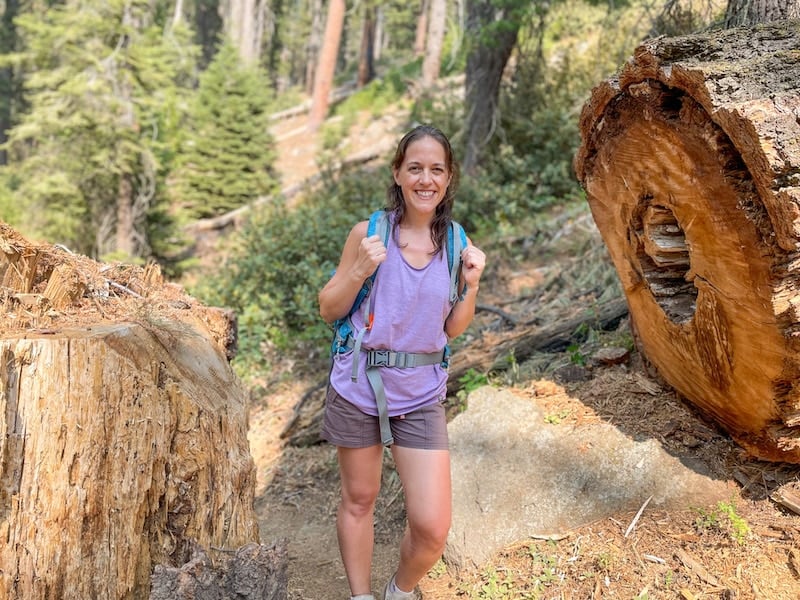
2 Unforgettable Itineraries For One Day In Sequoia National Park
Now we’ll look at some options for exactly how to spend one day at Sequoia National Park. Feel free to mix-and-match the options to best suit your interests or add in some of the attractions mentioned above.
Keep in mind, simply driving through the park and staring up at the giant sequoia trees is a treat.
If you don’t have to drive, I recommnd having your camera ready to record videos of the beautiful scenery — and wildlife! I actually spotted a bear up on a hill on the side of the road within 20 minutes of entering the park.
One Day In Sequoia National Park (Easy-to-Moderate Itinerary)
Best Sequoia Entrance: Ash Mountain Entrance
Today we’ll be spending the day in the Giant Forest and Lodgepole area of the park, known for its big trees. In fact, here you’ll find the world’s largest tree as well as the biggest unlogged sequoia tree on the globe.
Luckily, there are many trails and attractions here that make for the perfect one day itinerary in Sequoia National Park, including:
1) Visit the General Sherman Tree.
This is the world’s largest tree by volume, and one of the top attractions in Sequoia National Park. A few fun facts about the General Sherman Tree include:
- 52,500 cubic feet in volume
- 2,200 years old
- 1,385 tons in weight
- 275 feet tall
- 102-foot circumference at the ground
- Its branches are almost 7 feet in diameter
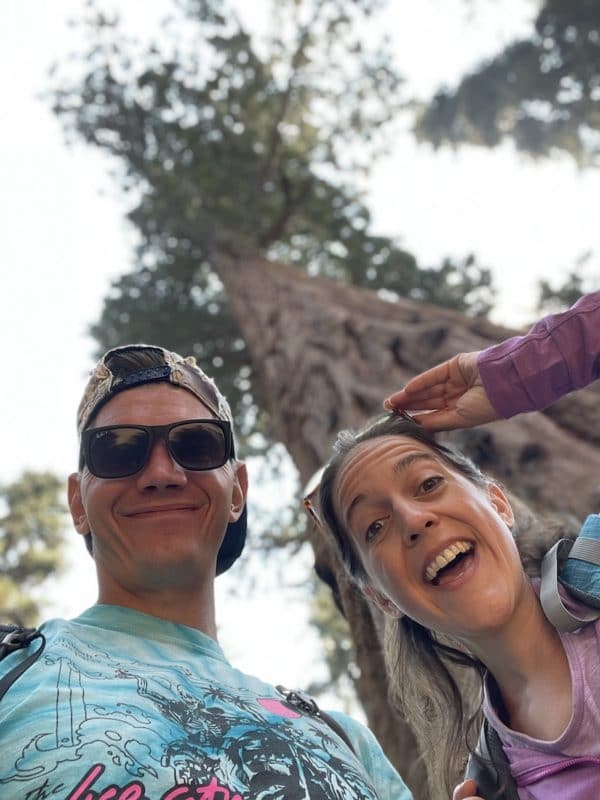
To reach the famous tree, you’ve got two options:
A 1-mile-round trip trail down and back up a set of paved stairs. While the way down is easy, the way up is steep and can be challenging.
Luckily, your other option is a gentle wheelchair-access trail that’s just a few hundred feet from an accessible parking area.
Once at General Sherman, pose for some photos — either by waiting in the long line or heading to the less-crowded back of the tree.
Interestingly, General Sherman is attached to a short loop that takes you to other interesting trees, like two sequoias that appear to be dancing. There is a sign that calls them “tough twins” as they feature huge fire scars so big you can actually walk into one of the trunks!
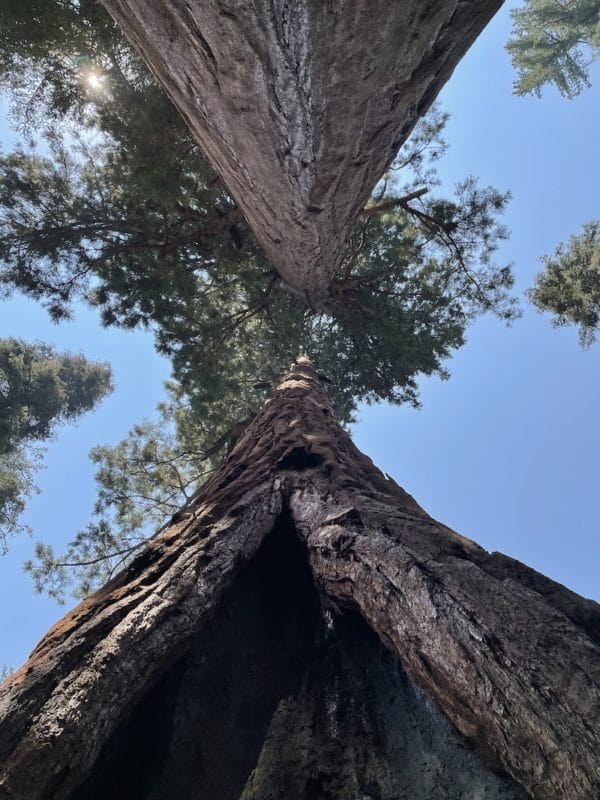
There are many other trails around here, too. In fact, if you’ve still got some energy you can continue on the Congress Trail, a short 2-mile loop showcasing huge sequoia trees.
2) Get familiar with Sequoia National Park at the Giant Forest Museum.
After meeting the famous General Sherman and exploring the giant sequoias nearby, drive over to the Giant Forest Museum to see exhibits on the park. It’s a great place to get an understanding of what exactly you’re looking at as you hike and explore.
Moreover, there is a gift shop selling books, maps, and postcards, as well as a schedule of events in case you’d like to take part in a ranger-led program or hike.
Right outside of the museum there are also a few natural landmarks — like Sentinel Tree, a giant sequoia that is the 21st largest tree in Sequoia National Park.
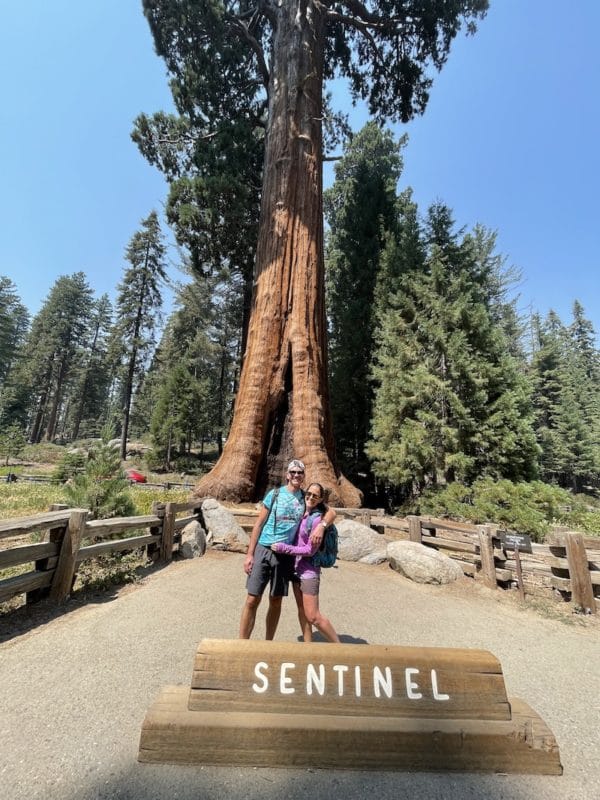
Actually, according to park signage, this tree is consdered average for a sequoia — despite the fact that it weighs 700 tons!
Across the street you’ll also see the Three Graces, a group of three giant sequoias that are extremely close together.
3) Hike the Big Trees Trail.
The Big Trees Trail is a 1-mile paved wheelchair-accessible loop right near the Giant Forest Museum that is absolutely stunning. You’ll hike around Round Meadow, which is hugged by towering sequoia trees.
It’s also considered an educational trail as there are signs sharing interesting information along the way.
A few of the trees are knocked down, making for some captivating scenery. Actually, a man in front of me actually climbed into one of the fallen trees and out the other end. I was afraid he would get stuck, but he made it!
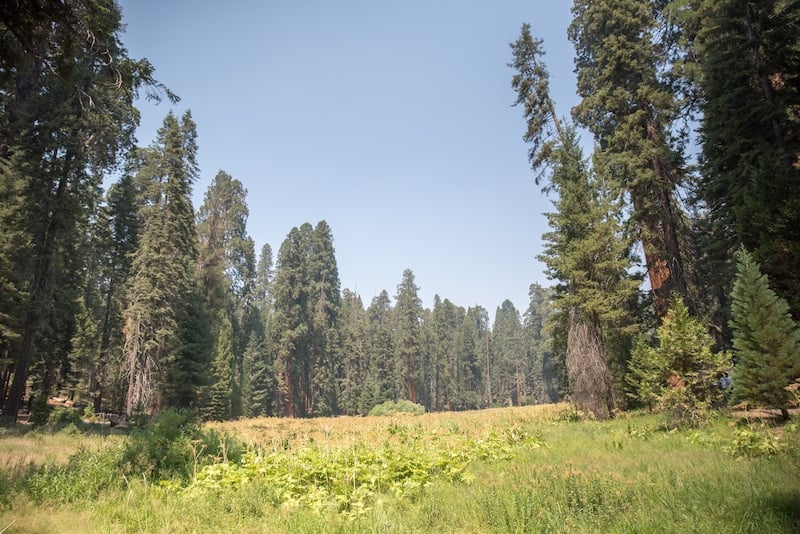
4) Continue hiking to Crescent Meadow.
As I noted above in the section on Top Sequoia National Park Attractions, there are many hikes and sites near the Big Trees Trail.
The thing is that many of these are short and often crowded. So, what I recommend is connecting a bunch of the lesser-known trails to reach the gorgeous Crescent Meadow, which is about 2.9 miles in total with an elevation gain of 748 feet (according to my AllTrails app) and takes you away from the crowds.
Here is a quick overview of the trails you’ll take on this moderate hike. This took us exactly 1 hour and 46 minutes to complete, including time to stop and take photos:
- Hazelwood Trail
- Alta Trail
- Huckleberry Trail
- Follow signs to Tharp’s Log & Crescent Meadow; you can take a shuttle back to Giant Forest Museum from the nearby Crescent Meadow Parking Lot
Stepping onto the Hazelwood Trail, you’ll quickly become immersed in towering sequoia trees — though sometimes you’ll also pass verdant green meadows lush with grasses and flowers that provide an important habitat for amphibians, birds, and bees.
While the General Sherman and Big Trees Trails are paved, this hike also allows you to get some dirt under your feet and really feel the solitude of the forest.

The hike is relatively easy for most of the way. It isn’t until the Huckleberry Trail that the flat path becomes a bit more challenging as it switches between ascending and descending — though the stunning scenery will undoubtedly energize you to continue.
By the way, keep your eyes peeled for wildlife as you hike. Along the way, my husband Andy and I saw a family of deer — two bucks and a doe — grazing.
You’ll also see a number of man-made attractions along the way, like Squatters Cabin, a log cabin built in the 1980s by a man who hoped to settle the land.
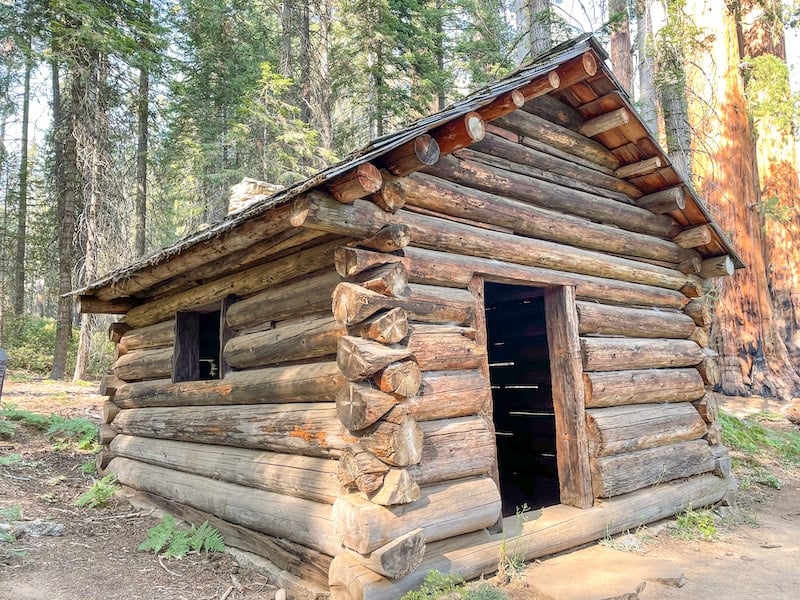
Unfortunately, after the cabin was complete he found out that the land was already settled by a man named Hale Tharp and so he was forced to leave.
Which brings us to our next attraction on the hike, Tharp’s Log, a hollowed-out sequoia tree that Mr. Tharp turned into a cabin! It’s really an impressive sight.
To end the trail, you can either hike back the way you came or walk the paved scenic path to the Crescent Meadow Parking Lot to take the free shuttle back to your car.
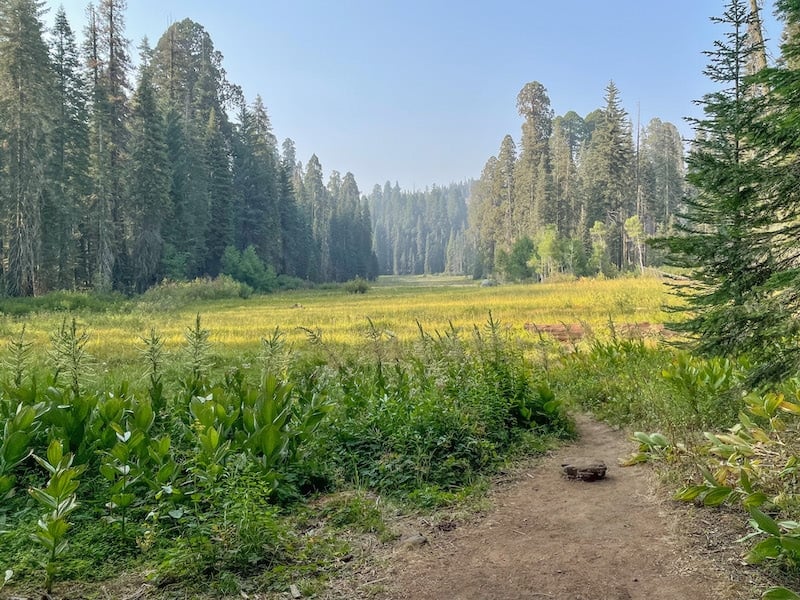
The latter is recommended, especially as the path to the parking lot offers a special treat:
Crescent Meadow, the namesake of the trail!
Because of its extreme beauty, author and environmental philosopher John Muir called Crescent Meadow the “Gem of the Sierras”. The golden grass seems to radiate sunshine up toward the tall sequoia trees and beyond to the blue skies.
If you’re wondering what to do in one day in Sequoia National Park, trust me when I say you won’t want to miss this stunning trail full of natural beauty and interesting attractions!
Sequoia National Park Hiking Video
Want to better immerse yourself in the above-mentioned hike? The below video takes you along the Hazelwood, Alta, and Huckleberry Trails to Crescent Meadow:
5) See the sunset at Sunset Rock.
Once back near the Giant Forest Museum, it’s about a 30-minute walk down a paved trail to reach Sunset Rock.
You’ll hike for about 0.7 miles on an easy scenic trail to Sunset Rock, a granite dome offering spectacular views of the foothills.
It’s the perfect way to end the day, though if you’d like something scenic that doesn’t require a 1.4-mile-round-trip hike head to Beetle Rock, located on the opposite side of the Giant Forest Museum Parking Lot.
This involves a very short walk along a paved wheelchair-accessible trail and awards you with views of Sequoia National Park’s western edge and the scenic San Joaquin Valley.
One Day In Sequoia National Park (Challenging Itinerary)
Best Sequoia Entrance: Ash Mountain Entrance
Now if you’re someone who wants maximum beauty and doesn’t mind putting in the effort for it, this one day Sequoia National Park itinerary is for you!
That’s because you’ll be doing the Lakes Trail, one of the best hikes in Sequoia National Park. While you won’t see many sequoias, if any, you’ll take in other stunning scenery — including three mountain lakes:
- Heather Lake
- Emerald Lake
- Pear Lake
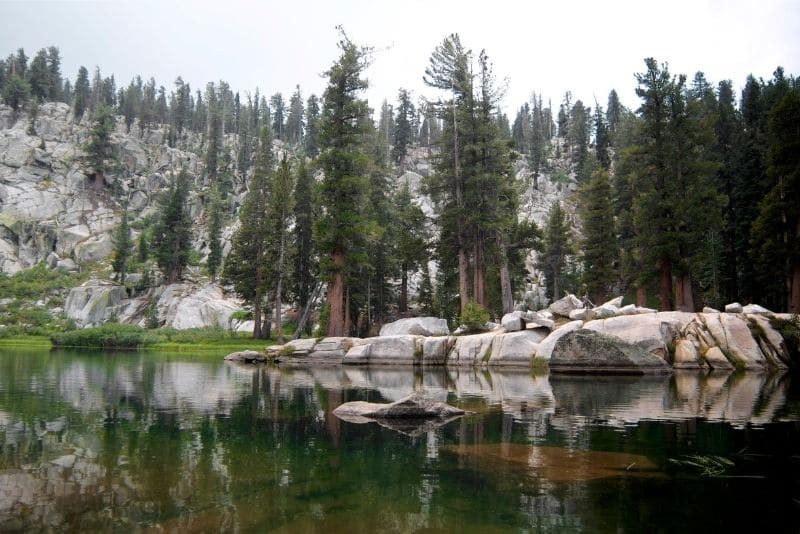
On top of that, the panoramic vista across the Tokopah Valley is truly jaw-dropping, not to mention the endless sea of granite you’ll be hiking through makes you feel far away from from hustle of civilization.
This 12.2-mile hike takes about 6-to-10 hours, with a total elevation gain of 2,792 feet. In fact, you’ll end up at 9,555 feet!
Speaking of heights, there are sections of this hike where the views are amazing — albeit you’re taking them in from a cliff edge without a guard rail with a 1,000-foot sheer drop down into the valley. It’s breathtaking, but just realize it can be scary if you have a fear of heights.
To reach the trail, turn off the Generals Highway at Wolverton Road, passing the turn to the General Sherman Tree. Stay on it until the very end — about a 5-minute drive — and you’ll come to a parking lot. The trailhead is on the left side.
You can read an in-depth guide to hiking the Lakes Trail in Sequoia National Park here.
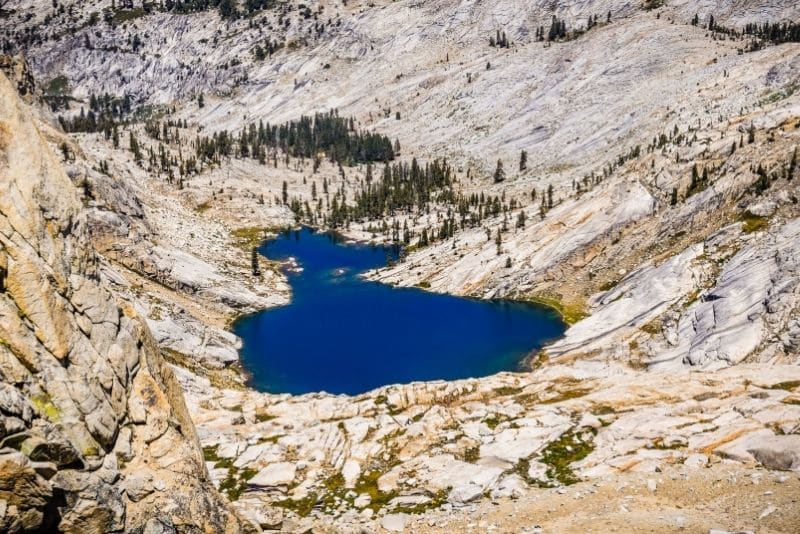
Tips For Visiting Sequoia National Park
Here are a few Sequoia National Park tips to help ensure you have an incredible and responsible trip:
-Know that you’re on Indigenous land. The Mono (Monache), Yokut, Tübatulabal, Paiute, and Western Shoshone were the original inhabitants of the land that Sequoia and Kings Canyon National Parks reside on. These Indigenous peoples were displaced and/or forced to relocate.
Along with educating yourself on the history and culture of these tribes, consider making a donation to causes and charities that directly support them. Moreover, where possible hire Indigenous guides and purchase from Indigenous-owned businesses.
-Don’t leave food or anything with a strong scent unattended or visible in your car as you may attract bears. This includes things like meals and snacks, hand sanitizer, cosmetics, trash, and cleaning supplies. Your best bet is to have a bear-proof box, though if you don’t then store items in a locked trunk.
-Keep wildlife wild. Do not feed, pet, or get too close to wildlife. If they become too used to humans they may become aggressive, and sadly may eventually need to be put down.
-Drive slowly. Make sure you’re going at or below the speed limit to avoid hitting animals.
–Understand what to wear when you go hiking. Items like moisture-wicking clothing, sunglasses, and a hat can help keep you safe and comfortable.
-Stay on marked hiking trails. Going off-trail can cause trail erosion.

Frequently Asked Questions About Visiting Sequoia National Park
Here are answers to frequently asked questions that can help make planning a Sequoia National Park 1 day itinerary much easier:
Q: How many days should I spend in Sequoia National Park?
You can absolutely spend just one day at Sequoia National Park and have an incredible time! That being said, if you can spend a few more days it’ll allow you to do more trails and explore the various areas of the park — including Kings Canyon National Park.
While a Sequoia National Park 4 day itinerary would probably be a good estimate, especially if you want to see things in both parks, the best way to truly determine the exact number of days to spend in the park is to map out exactly what you want to do and create an itinerary based on that.
Q: Can you see Sequoia National Park in a few hours?
Yes, it is possible to do a few easy hikes or one moderate hike in a few hours and potentially visit a few attractions, like the Giant Forest Museum, and viewpoints, like Beetle Rock.
Just note that the drive into the park can be long. For instance, driving from the Ash Mountain Entrance to the Giant Forest Museum takes about 45 minutes.
Q: How far is Kings Canyon from Sequoia National Park?
Generals Highway connects Sequoia and Kings Canyon National Parks, beginning at the Sequoia National Park’s Ash Mountain Entrance and continuing on until the town of Grant Grove in Kings Canyon.
Driving from the Ash Mountain Entrance to Grant Grove takes about an hour and a half.
Q: Can I visit Kings Canyon and Sequoia National Park in one day?
Yes, it is possible — though you’ll definitely want to start early as well as have a vehicle. Then you can plan to spend about four-to-six hours in each park.
Q: How do I get from Sequoia National Park to Kings Canyon National Park?
The best way is by car. As mentioned above, Generals Highway connects Sequoia and Kings Canyon National Parks.
Q: Can you drive through Sequoia National Park?
Yes! It’s a beautiful drive, too.
Q: Is it possible to do a day trip to Sequoia National Park from San Francisco?
While it’s possible, particularly if you wake up before sunrise, it would be an extreme amount of driving at 4.5 hours each way — not to mention the driving you’ll need to do around the park.
If possible, I’d recommend trying to at least come a day early and/or spend the night of your park visit at a hotel near Sequoia National Park.
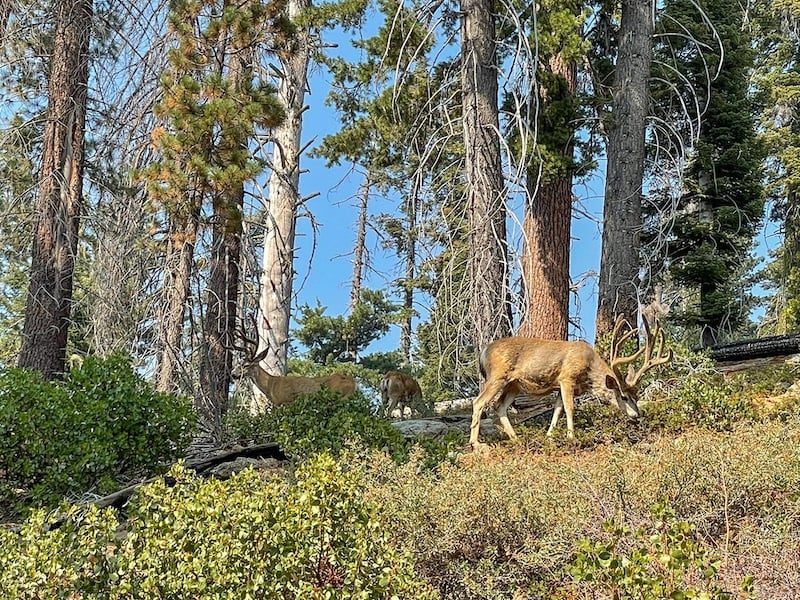
Sequoia National Park Tours
Looking to explore Sequoia National Park and its surroundings with a guide? Here are a few highly-rated experiences:
- Private Guided Hiking Tours in Sequoia and Kings Canyon National Parks
- Sequoia National Park Adventure from Tulare
- Sequoia National Park Snowshoe Adventure from Three Rivers
- Stargazing in Sequoia National Park
Click here for a full list of Sequoia & Kings Canyon National Park experiences!
Sequoia National Park Travel Insurance
When visiting Sequoia National Park — or anywhere else in the world — it’s wise to get travel insurance.
One of the best travel medical insurance for travelers is SafetyWing as they’ve got a large network and offer both short-term and long-term coverage — including coverage if you’re traveling for months as well as limited coverage in your home country).
Additionally, SafetyWing is budget-friendly and offers $250,000 worth of coverage with just one low overall deductible of $250.
Click here to price out travel insurance for your trip in just a few clicks.
Other California Hiking Trails
Looking to do other California hiking trails? A few not-to-miss trails include:
1, 2, & 3 Day Itinerary For Yosemite National Park
Lost Horse Mine in Joshua Tree National Park
Hidden Valley Trail in Joshua Tree National Park
Ryan Mountain in Joshua Tree National Park
Mount Whitney in the Sierra Nevadas
The Lakes Trail in Sequoia National Park
James Irvine Trail to Fern Canyon in Prairie Creek Redwoods State Park
Sentinel Dome to Glacier Point in Yosemite National Park
Columbia Rock Trail in Yosemite National Park
How To Hike Vernal & Nevada Falls via The Mist Trail in Yosemite National Park
What would you do with one day in Sequoia National Park?
Enjoyed this one day itinerary for Sequoia National Park? Pin it for later!

Hi, I’m Jessie on a journey!
I'm a conscious solo traveler on a mission to take you beyond the guidebook to inspire you to live your best life through travel. Come join me!
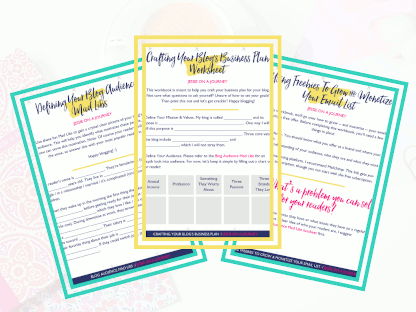
Want to live your best life through travel?
Subscribe for FREE access to my library of fun blogging worksheets and learn how to get paid to travel more!

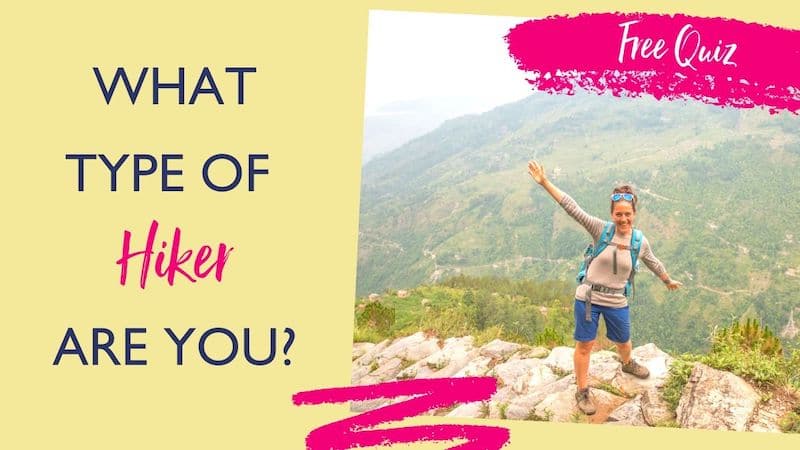

This has got to be one of the stupidest articles I have ever read. Sequoia National Park is almost completely closed now. You have no business writing articles about going there, when because of fires the park is closed. You can’t drive through it.
@Jane: I was just there and drove through the park and did all of the activities mentioned above. Shuttles were running, bathrooms were open, trails were open, etc. As noted in the post, with COVID/forest fires it’s essential to stay up-to-date and check the park website before visiting.